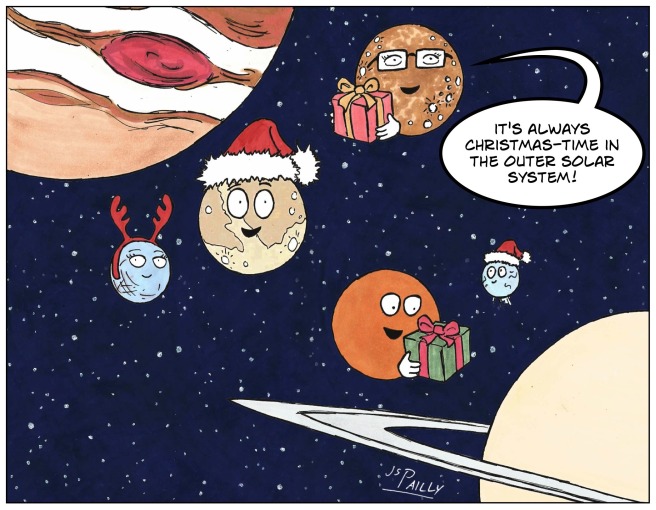Welcome to a very special holiday edition of Sciency Words! Today’s science or science-related term is:
FROST LINE
When a new star is forming, it’s typically surrounded by a swirling cloud of dust and gas called an accretion disk. Heat radiating from the baby star plus heat trapped in the disk itself vaporizes water and other volatile chemicals, which are then swept off into space by the solar wind.
But as you move farther away from the star, the temperature of the accretion disk tends to drop. Eventually, you reach a point where it’s cold enough for water to remain in its solid ice form. This is known as the frost line (or snow line, or ice line, or frost boundary).
Of course not all volatiles freeze or vaporize at the same temperature. When necessary, science writers will specify which frost line (or lines) they’re talking about. For example, a distinction might be made between the water frost line versus the nitrogen frost line versus the methane frost line, etc. But in general, if you see the term frost line by itself without any specifiers, I think you can safely assume it’s the water frost line.
Even though our Sun’s accretion disk is long gone, the frost line still loosely marks the boundary between the warmth of the inner Solar System and the coldness of the outer Solar System. The line is smack-dab in the middle of the asteroid belt, and it’s been observed that main belt asteroids tend to be rockier or icier depending on which side of the line they’re on.
It was easier for giant planets like Jupiter and Saturn to form beyond the frost line, since they had so much more solid matter to work with. And icy objects like Europa, Titan, and Pluto—places so cold that water is basically a kind of rock—only exist as they do because they formed beyond the frost line. This has led to the old saying:

Okay, maybe that’s not an old saying, but I really wanted this to be a holiday-themed post.
Merry Christmas to you James, whichever side of the frost line you find yourself this holiday!
LikeLiked by 1 person
Hey thanks, and same to you!
LikeLike
As I understand it, one of the big mysteries is how Earth, being inside the frost line, managed to hold on to so much water, when it was basically blown away by the solar wind everywhere else within the inner system. The most prominent theory is comet impacts in the late bombardment period, but apparently that theory is not without problems.
Depending on how unusual the circumstances were, it could be a factor in the pervasiveness of life, at least in environments like ours on the surface of rocky worlds.
Merry Christmas!
LikeLiked by 1 person
I’m inclined to believe that comets reintroduced water to Earth and the other planets of the inner Solar System. Didn’t know there were any major problems with that idea. Sounds like something I should do more research on.
LikeLiked by 1 person
From what I recall, the problem has something to do with differences in the chemical properties of Earth water versus comet water. When reading about it, I remember wondering why four billion years of Earth water going through its hydrologic cycle couldn’t account for that, but all I remember was because complicated-chemistry-stuff 🙂
LikeLiked by 2 people
Oh good! Sounds like a job for Molecular Mondays!
LikeLiked by 2 people
Looking forward to it, particularly if it turns out the problem is bogus.
LikeLiked by 1 person
Merry Christmas
LikeLiked by 1 person
Chemistry is more warmer in Winter Wonderland
LikeLiked by 1 person
That it is! Thanks for stopping by!
LikeLike